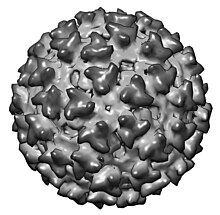Sindbis-Virus
Sindbis virus is a viral species of the genus Alphavirus. It is the causative agent of a mostly harmless febrile illness with inflammation of the joints that often accompanies partly with rashes and encephalitis. The virus is transmitted by mosquitoes and is in Central Europe than imported trip infection. Due to its transmission path is attributed to the epidemiological group of arboviruses. Some subtypes of Sindbis virus have been identified as the causative agent of Karelian fever and Ockelbo fever.
Discovery
The Sindbis virus was discovered in 1952, after about 30 km north of Cairo is examined several species of mosquitoes ( Culex pipiens and Culex univittatus ) from a pond near the village of Sindbis (Egypt ) on possible cause of a broken febrile illness.
System
The Sindbis virus forms within the genus Alphavirus a special group of viruses ( WEEV Group, Western equine encephalitis virus complex) which also includes the Fort Morgan virus ( Buggy Creek virus), Highlands J virus, Western Equine encephalomyelitis virus, and Whataroa virus belong. The species Sindbis virus is divided into six subtypes with ( historically ) his own name:
- Species: Sindbis virus
- Subtype: Babanki virus
- Subtype: Kyzylagach virus ( Azerbaijan)
- Subtype: Sindbis -like virus
- Subtype: Sindbis -like virus YN87448
- Subtype: Karelian fever virus ( Karelia )
- Subtype: Ockelbo virus ( Sweden)
Epidemiology
All alphaviruses are transmitted by blood-sucking vectors. In the case of Sindbis virus dissemination is carried by mosquitoes of the genus Culex. Birds are the natural reservoir of the virus. Due to the vector, the distribution of Sindbis virus to Africa, the Eastern Mediterranean, Sicily, South and Southeast Asia, South America and Australia is limited. In Central Europe, occurring infections with Sindbis and Sindbis -like viruses have been imported infection, after a stay in vulnerable regions. In Sweden, the Ockelbo virus and Eastern Europe (Czech Republic, Karelia ) was found the virus of Karelian fever. Overall, these virus subtypes are less pathogenic. Because of the bird migration a presence of the virus in Central Europe has long been believed, but viral RNA of Sindbis virus subtype in 2010 in southern Germany in the mosquito Anopheles maculipennis, Culex torrentium and Culex pipiens could be detected. The specified subtype is related to the Swedish subtype ( Ockelbo virus). However, the most common local of mosquito Aedes vexans is not able to multiply and destroy the virus absorbed Sindbis virus by digestion ( proteolytic cleavage ) of the viral envelope.
Disease
An infection with Sindbis virus causes after an incubation period of 3-4 days only in rare cases a febrile illness ( Sindbis fever), some with skin eruptions ( exanthema ) and joint problems. The clinical picture is very similar to a dengue infection, which is why we also speak of a so-called dengue -like syndrome in Sindbis virus. The most conspicuous symptom of arthritis owes the Sindbis virus infection, the term " epidemic polyarthritis ". In a few cases Sindbis viruses have been described with neurotropic property and an associated encephalitis.
The infection heals even without specific therapy mainly from without consequences. Vaccination is currently not available.










